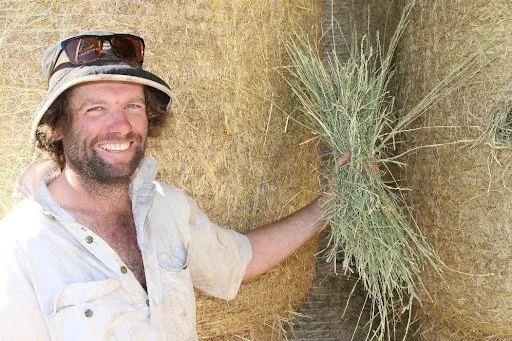Hay Guard is “Cheap Insurance”
South West Victoria is not known for its hay production.
Sure, the lush dairy country with a livestock carrying capacity to rival some of the best regions in Australia has a lot going for it. But when it comes to homegrown roughage, the quality of south west “hay” has often been the butt of many industry jokes.
It’s long been accepted that “good hay” comes from elsewhere, and purchasing it is just part of the cost of doing business in this high and predictable rainfall environment. But for Matthew Glennen – a dairy farmer from Dixie near Terang – this isn’t the case.
His family farming operation, including 650 milkers and a growing beef herd, produces all its own fodder. The perennial and Italian ryegrass pasture and wheat hay they produce is nothing like “the glorified straw” the region can be known for, and Matthew has the feed tests to prove it.
But more importantly, producing his own hay for dry and springing cows decreases feed costs and enables better agronomic management to get the most out of pasture regrowth.
“Our hay, that we have done this year, we got it all off within a five-to-seven-day window,” Matthew said. “It’s all a beautiful green colour and in the shed and it was all baled at 18-20 per cent moisture.”
High moisture and early-season baling were possible thanks to a preservative called Hay Guard® - a product Matthew first trialed three years ago when preparing to bale wheat. Matthew understood the challenges of chasing quality cereal hay in a region where rain fell nearly 120 days of the year.
“Doing cereal hay in Wimmera, for example, you sit it on the ground to cure for three weeks or so,” he said. “If you sit that same crop on the ground here in the western district for three weeks, I can guarantee you will get rain on it. We basically first looked at it to get the wheat hay in a lot earlier.”
For two of the past three years this wheat crop has been made into valuable hay for the dairy herd. Hay, for the Glennen family, is harvested after silage and is the smallest portion of the dairy farm’s supplementary fodder. It’s used as part of the grazing management to maximise the tonnages grown from every part of the family’s 300ha milking platform and 180ha out-block. Only surplus pasture gets made into hay and paddocks are locked-up for the shortest possible time.
Traditionally, the family would produce 800-1000 dry tonnes of silage a year and 300 tonnes of hay.
“Silage is a major portion of our conserved fodder, but the cost of silage wrapping, plastic all the rest adds an extra $40-$50 dollars a dry tonne,” Matthew said. “So, when we can, especially when grass is more mature, we do hay. “
All hay is tested for DCAD (dietary cation-anion difference) with the lowest DCAD hay fed to “springing” cows as part of their lead-feed diet.
“The better-quality hay we can produce here, it means we can make sure our springer diets are the best quality we can get, same as our dry cows,” Matthew said.
“Without our own better-quality hay, we either have to buy it in or use the hay we make and potentially supplement it with silage to make sure the diet is satisfactory. That would add extra cost to the diet.”
Hay Guard® Australia and New Zealand product specialist Mark Lourey said improving the quality of homegrown hay made financial sense for dairy farmers.
“It means you wouldn’t need to buy-in cereal hay at $240 a tonne – or more,” he said. “Instead, Hay Guard® means you can grow hay with the same energy requirements.”
Applying Hay Guard® during the baling process makes economic sense for Matthew, he said it provides a return on the investment and has been “cheap insurance”.
“Using Hay Guard® we can cut earlier which means we get better quality hay, we aren’t waiting for the middle of December – by the time the rain has stopped – and then it’s glorified straw,” Matthew said.
“If it’s better quality, we get better returns.”
During the past two seasons, an earlier pasture hay harvest has also enabled the Glennens to maximise regrowth through timing and strategic fertilizer applications.
“Overall, we are potentially growing more tonnes from that same paddock,” Matthew said.
Hay Guard® has also ensured Matthew can make the most of the farm’s ample hay storage facilities. Before using the preservative, he would have feared spontaneous combustion within the hay if it were stored in sheds and baled at the same 18-20 per cent moisture. Hay Guard® not only provides this peace of mind it also maximises the return from producing hay. Hay stored outside can lead to wastage of up to 20 per cent, but even at half this, there’s still a margin after applying Hay Guard®.
At $120 a tonne for pasture hay, the $8 a tonne investment in Hay Guard®, delivers a $4 a tonne- minimum – saving in wastage, according to Matthew. Across 600 round bales, this is at least $2400 without considering the quality, timing and palatability improvements Hay Guard® delivers.
“It is pretty cheap insurance, we are not going to have hay that is going to end up burning, going mouldy or musty,” Matthew said. “At $8 a tonne, to be able to cut a week, 10 days or two weeks earlier to guarantee better quality and potential regrowth – it is pretty cheap, I think.”


